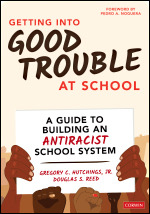Getting Into Good Trouble at School
A Guide to Building an Antiracist School System
Foreword by Pedro A. Noguera
Turn the promise of equitable education into reality.
This is your guidebook for building an antiracist school. Written by two education leaders with very different life experiences, Getting into Good Trouble At School provides the context, empowerment, and concrete actions needed to dismantle racist policies and practices that for decades have kept students of color from experiencing the same success as their white counterparts.
The journeys of Gregory Hutchings and Douglas Reed – which include systemic racism and white privilege - provide a unique model superintendents, principals, school board members and other educators can use to reimagine educational equity, actively dismantle institutional racism, and implement strategic, methodical policies that benefit the entire school community. In this book you’ll find
- A detailed case study of antiracist educational transformation
- What it really means to commit to racial equity
- Guidance for dismantling tracking and in-school segregation
- Positive, equitable alternatives to typical disciplinary practices
- Six steps to building an antiracist school system
Racism isn’t always intentional. Antiracism, on the other hand, must be. Now antiracist education leaders can put their intentions into action—and grant the promise of an equitable and culturally rich education to all students.
Free resources
Chapter 1: Reimagining the Titans
The cessation of overtly racist practices is not enough to halt the effects of racism. We need, in the words of Ibram X. Kendi, to become antiracists—as teachers, school leaders, parents, and community members.
Introduction
How do teachers, students, parents, school leaders, and admin-istrators build an antiracist school system?
Gregory C. Hutchings, Jr. and Douglas S. Reed have produced a thoughtful, important, and timely book. It is essential reading for school leaders who value racial equity enough to put it into practice and for policymakers and advocates as well.
Getting Into Good Trouble at School is a must-read for anyone interested in the future of American education. Drs. Hutchings and Reed identify six essential steps. If absorbed and applied, these steps will serve as waypoints in the pursuit of critical change supporting all students in constructing an antiracist school system.
This book is a powerful and thoughtful analysis of the enduring impact of institutional racism upon American education. Hutchings and Reed combine deeply personal reflections and anecdotal narratives about how racism has impacted minority students. The book is a strong endorsement for using strategic planning and the continuous improvement process to build a transformed system that is aligned, mission- and vision-driven, culturally responsive, and personalized.
This is a book that every educator and every parent should read. It is clear, comprehensive, and tells the unsettling truth about racism in public schools in America. It lays out specific steps to once and for all dismantle the racism that continues to plague our society and deny BIPOC children their right to an equitable education.
Hutchings and Reed offer a direct approach to confronting systems of racism. Through sharing personal experiences, a deep knowledge of the existing literature, and data informed practices, the authors offer a call to action that requires assessing current practices, establishing an intentional strategic plan, and being courageous enough to implement the plan.
Here, finally, are authors with the courage to lay out concrete steps school leaders can take to encourage antiracist schools to grow and thrive. Gregory C. Hutchings, Jr. and Douglas S. Reed offer six steps to dismantle systemic racism in American schools while getting into “good trouble” to help Americans live out the full meaning of “all men (and women) are created equal.
This courageous text provides testimonies of lived experiences interwoven against a historical backdrop of the impact of racism on our educational system. It takes the reader on a journey to understand how to advance an equity lens and become an antiracist educator. The authors artfully challenge the status quo while the guided questions force you to reflect and act.
As educators are doubling down on efforts to reimagine student- centered, forward-leaning public education, Getting Into Good Trouble at School points out why it’s essential to boldly advocate for the vast number of U.S. children who should be receiving the services that they are entitled to. I congratulate the authors for casting a shining light on the principles of educational equity and social justice.
This is a useful book that every classroom can benefit from.
Sample Materials & Chapters
Chapter 1. Reimagining the Titans
Chapter 2. Know Your History to Rewrite Your Future

